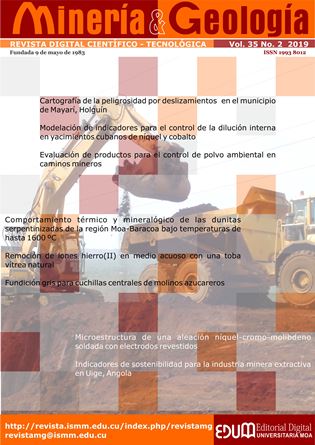Microstructure of a nickel-chromium-molybdenum alloy welded with coated electrodes
Keywords:
comportamiento microestructural, aleación, ferrita, austenita Widmanstátten.Abstract
Nickel-chromium-molybdenum alloys are especially used in manufacturing components for the aeronautical and the petrochemical industries. This article focused on determining the microstructural performance of this kind of alloy, welded with E NiCrFe-3 of 3,25 mm diameter electrode. The butt welding was obtained by preparing the edges at 60°. The microstructural variations were evaluated by optical microscopy, and the hardness analysis was carried out in the affected areas by the thermal welding cycle. To determine chromium and nickel equivalent, the Schaeffler diagram was used, which allowed obtaining the chemical composition resulting from the deposit. The structure of this alloy in the joint is austenitic, and it was determined by structural transformations consisting of skeleton type ferrite morphology, aligned the heating source of the electric arc. It was also proved the formation phases of primary austenite, austenite Widmanstátten, and the precipitation of secondary austenite to the interior of the ferrite, where structure of austenite Widmanstátten is the most fragile.Downloads
References
Agarwal, D. 2000: Nickel and nickel alloys. In: Uhlig´s corrosión Handbook. R. Winston Revie (ed.). New York: John Wiley & Sons, Inc., p. 831-851.
Dye, D.; Hunkinzer, O.; Roberts, S. y Reed, R. 2001: Modelling of the mechanical effects induced by Tungsten Inert Gas Welding of IN718 superalloy. Metallurgical and Materials Transactions A, 32(7): 1713-1725.
Fernández-Columbié, T.; Rodríguez-González, I.; Alcántara-Borges, D. 2016: Caracterización microestructural de uniones soldadas de acero AISI 316L en tuberías. Minería y Geología, 32(1): 60-75.
Fernández-Columbié, T.; Rodríguez-González, I.; Correa-Suárez, R. E. y Alcántara-Borges, D. 2014: Junta de soldadura disímil de la aleación HK-40 y del hierro fundido 24. Ingeniería Mecánica, 17(2): 98-107.
Guirao, J.; Rodríguez, E.; Bayón, A.; Bouyer, F.; Pistono, J. y Jones, L. 2010: Determination through the distortions analysis of the best welding sequencing longitudinal welds VATS electron beam welding FE simulation. Fusion Engineering and Design, 85(11): 766-779.
Henderson, M.; Arrell, D.; Heobel, M.; Larsson, R. y Marchant, G. 2004: Nickel-based superalloys welding practices for industrial gas turbines applications. Science and technology of welding and joining, 9(1): 13-21.
Huang, X.; Chaturvedi, M. y Richards, N. 1996: Effect of homogenisation heat treatment on the microstructure and heat affected zone microfissuring in welded cast alloy IN718. Metallurgical and materials Transactions A, 27(3): 785-790.
Lo, K.; Shek, C. y Lai, J. 2009: Recent developments in stainless steels. Materials Science and Engineering, 65(4): 39-40.
Plaza, L.; Eizaguirre, I.; Barreda, J.; Azpiroz, L.; Jiménez, C. y Irisarri, A. 2007: Predicción del riesgo de agrietamiento de las uniones soldadas de las aleaciones base níquel. Anales de la Mecánica de Fractura, 1: 51-56.
Ricaurte, O.; Aguirre, H. y Parra, H. 2007: Soldabilidad en aceros inoxidables y aceros disímiles. Scientia et Technica, 13(2): 273-278.
Rodríguez, G.; García, I. y Damborenea, J. 1998: Aleación superficial de superaleaciones base níquel mediante laser. Revista de metalurgia, 34(2): 175-179.
Sánchez, V.; Ramírez, C.; Rubio, C. y Chaparro, J. 2006: Susceptibilidad a la fractura inducida por hidrógeno de soldadura de placa Clad de acero inoxidable 12% Cr. Información Tecnológica, 17(2): 53-62.
Villanueva, D.; Junio, F.; Plaut, R. y Padilha, A. 2006: Comparative study on sigma phase precipitation of three types of stainless steels: austenitic, superferritic and duplex. Materials Science and Technology, 22(9): 1098-11
Published
How to Cite
Issue
Section
Copyright (c) 2019 Tomás Hernaldo Fernández-Columbié, Isnel Rodríguez-González, Miguel Ángel Cobas-Suárez, Maite Aldana-Cruz, Marcos Medina-Arce

This work is licensed under a Creative Commons Attribution-NonCommercial 4.0 International License.
- Authors retain copyright and guaranteeing the right magazine to be the first publication of the work as licensed under a Creative Commons Attribution-NonCommercial that allows others to share the work with an acknowledgment of the work's authorship and initial publication in this journal.
- Authors may establish separate supplemental agreements for the exclusive distribution version of the work published in the journal (eg, place it in an institutional repository or publish it in a book), with an acknowledgment of its initial publication in this journal.
- Authors are allowed and recommended to disseminate their work through the Internet (e.g., in institutional telematic archives or on their websites) before and during the submission process, which can produce interesting exchanges and increase citations of the published work. (See The effect of open access)










